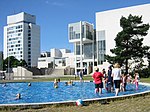EMMA – Espoo Museum of Modern Art

The EMMA – Espoo Museum of Modern Art (Finnish: EMMA - Espoon modernin taiteen museo, Swedish: EMMA - Esbo moderna konstmuseum), is a major art museum in Espoo in southern Finland. After the founding of Espoo Art Museum Foundation in September 2002, EMMA opened its doors for visitors in 2006. With its 5000 square metre exhibition space, it is the largest museum in the whole of Finland. The permanent exhibition presents a selection from The Saastamoinen Foundation Art Collection and the other half the changing domestic and international exhibitions. It is housed in the WeeGee house, a building complex which contains five museums, a modern art gallery, a media-art centre, a café, a museum shop and an art school. The centre was named after the printing firm Weilin+Göös.
Excerpt from the Wikipedia article EMMA – Espoo Museum of Modern Art (License: CC BY-SA 3.0, Authors, Images).EMMA – Espoo Museum of Modern Art
Ahertajantie, Espoo Tapiola (Suur-Tapiola)
Geographical coordinates (GPS) Address Website Nearby Places Show on map
Geographical coordinates (GPS)
| Latitude | Longitude |
|---|---|
| N 60.178611111111 ° | E 24.794166666667 ° |
Address
Näyttelykeskus WeeGee
Ahertajantie 5
02100 Espoo, Tapiola (Suur-Tapiola)
Finland
Open on Google Maps








